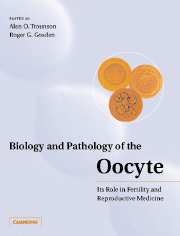Book contents
- Frontmatter
- Contents
- List of contributors
- Preface
- Part I Historical perspective
- Part II Life cycle
- Part III Developmental biology
- Part IV Pathology
- Part V Technology and clinical medicine
- 17 Growth and development of the mammalian oocyte-granulosa cell complex in culture
- 18 Human oocyte maturation in vitro
- 19 Follicular factors affecting oocyte maturation and developmental competence
- 20 Low temperature storage of follicular and ovulated oocytes
- 21 Fecundity of transplanted ovaries
- Index
19 - Follicular factors affecting oocyte maturation and developmental competence
from Part V - Technology and clinical medicine
Published online by Cambridge University Press: 05 August 2016
- Frontmatter
- Contents
- List of contributors
- Preface
- Part I Historical perspective
- Part II Life cycle
- Part III Developmental biology
- Part IV Pathology
- Part V Technology and clinical medicine
- 17 Growth and development of the mammalian oocyte-granulosa cell complex in culture
- 18 Human oocyte maturation in vitro
- 19 Follicular factors affecting oocyte maturation and developmental competence
- 20 Low temperature storage of follicular and ovulated oocytes
- 21 Fecundity of transplanted ovaries
- Index
Summary
Introduction
The oocyte and the follicle are, in the female mammal, intimately linked from the early phases of gam - etogenesis. They form a duo in which the death of one component normally induces the death of the other. During the passage from the primordial to the primary and the secondary stages, both compartments show a large number of synchronized changes indicating that, even at the earliest stage, they influence or depend on each other. Until the oocyte reaches its full size, it is quite clear that the follicular cells provide substrate, as well as complementary proteins necessary for oocyte function. The competence of the fully grown oocyte varies according to species. In the mouse, the ability to resume meiosis is reached around a diameter of 70 µm while the ability to be fertilized and normal development is only achieved when the oocyte reaches maximum size (First et al., 1988). In domestic animals, the acquisition of developmental competence is not necessarily achieved in full-size oocytes. It seems that other differentiation events relating to follicular development are required for the full developmental competence to be achieved.
In this chapter, the importance of different aspects of follicular development will be analysed for their influence on the ability of the oocyte to be aspirated, to mature in vitro and to develop as a normal embryo following fertilization. Since the dynamics of the interaction between the oocyte and the follicle compartment are similar in farm animals and humans, most of the examples are drawn from the cow and, when available, a comparison will be made with information available for other species.
In animals, a rationale for the apparent cross-talk between the oocyte and the follicle comes from the requirement for the ovulation of an oocyte at the right time since most animals do not mate at random during the sexual cycle. The reproductive behaviour in most animals limits the sexual interaction to the period immediately before or after ovulation to achieve a maximal rate of conception. The connection between the ovulatory process and reproductive behaviour is mainly linked to the absolute level of circulating oestradiol 17β which is produced mainly by a mature follicle containing a fully grown oocyte.
- Type
- Chapter
- Information
- Biology and Pathology of the OocyteIts Role in Fertility and Reproductive Medicine, pp. 305 - 315Publisher: Cambridge University PressPrint publication year: 2003
- 4
- Cited by



